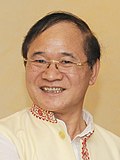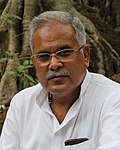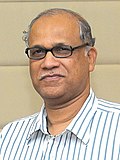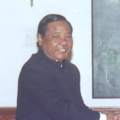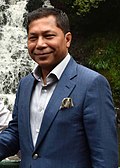Top Qs
Timeline
Chat
Perspective
List of chief ministers from the Indian National Congress
Political party from India From Wikipedia, the free encyclopedia
Remove ads
The Indian National Congress (INC) is one of the two major parties in the political system of the Republic of India.[1][2] As of 20 November 2024, INC is in power in the three states: Himachal Pradesh, Karnataka and Telangana. In Tamil Nadu and Jharkhand, it shares power with alliance partners Dravida Munnetra Kazhagam and Jharkhand Mukti Morcha respectively.[3] In the post-independence era, the party has governed most of India's states and union territories, and by extension, has the status of a "national party" in India.[4]
According to the Constitution of India, at the state level, the governor is de jure head, but de facto executive authority rests with the chief minister.[5] Therefore, the chief minister is considered the head of government in his jurisdiction.[6] Following elections to the state legislative assembly, the governor usually invites the party or coalition with a majority of seats to form the government. The chief minister is appointed by the governor, who also appoints other ministers, known as the council of ministers, based on the chief minister's advice.[7] The council of ministers is collectively responsible to the state legislative assembly, ensuring unified support for all governmental decisions.[5] The Chief Minister's term is normally limited to five years if they have the assembly's confidence. There are no limits to the number of terms the chief minister can serve.[8] The deputy chief minister is a member of the state government and usually the second highest ranking executive officer of their state's council of ministers.[9] Because the deputy chief minister is not a constitutional office, the Chief Minister has significant influence over the scope of authority and duties the deputy chief minister can perform. A deputy chief minister usually holds a cabinet portfolio such as home minister or finance minister.[10] In the parliamentary system of government, the chief minister is treated as the "first among equals" in the cabinet; the position of deputy chief minister is used to bring political stability and strength within a coalition government.[11]
Five of the INC chief ministers have been women – Sucheta Kripalani for Uttar Pradesh, Nandini Satpathy for Odisha, Anwara Taimur for Assam, Rajinder Kaur Bhattal for Punjab, and Sheila Dikshit for Delhi. The longest-serving female chief minister was Sheila Dikshit, who served as the chief minister of Delhi for over fifteen years.[12] Okram Ibobi Singh, who was chief minister of Manipur for 15 years and 11 days between March 2002 and March 2017, has been the longest-serving chief minister of the state.[13] Tarun Gogoi held the position of chief minister in Assam for a period of 15 years and 6 days.[14] A leader of the Indian National Congress, Virbhadra Singh holds the distinction of being the longest serving chief minister of Himachal Pradesh, holding the office from 1983 to 1990, from 1993 to 1998, from 2003 to 2007 and finally from 2012 to 2017.[15] Gegong Apang has not only been the longest-serving chief minister from the INC but also in the history of Arunachal Pradesh.[16] Apang also holds the record for the fourth-longest-serving chief minister of an Indian state, holding the post for over twenty-two years.[17]
Remove ads
Andhra Pradesh
Remove ads
Arunachal Pradesh
Remove ads
Assam
Bihar
Remove ads
Chhattisgarh
Delhi
Remove ads
Goa
Remove ads
Gujarat
Remove ads
Haryana
Himachal Pradesh
- Key
- * – Incumbent chief minister
Remove ads
Jammu and Kashmir
Remove ads
Karnataka
- Key
- * – Incumbent chief minister
Kerala
Madhya Pradesh
Maharashtra
Manipur
Meghalaya
Mizoram
Nagaland
Odisha
Summarize
Perspective
Punjab
Puducherry
Rajasthan
Sikkim
Tamil Nadu
Summarize
Perspective
Telangana
- Key
- * – Incumbent chief minister
Tripura
Uttar Pradesh
Uttarakhand
West Bengal
See also
Notes
- United Andhra Pradesh, was officially established on 1 November 1956, through the enactment of the States Reorganisation Act in August 1956. This led to the dissolution of Hyderabad State, with its divisions becoming part of Mysore State and Bombay State.
- Khandu became the chief minister in July 2016 while being a member of the INC.[21] He joined the People's Party of Arunachal in September 2016,[21] and later defected to the BJP in December 2016.[22]
- Part-C States were a category of states and territories that existed under the Constitution of India before they were reorganized or merged into other categories of states. This classification was part of the First Schedule of the Indian Constitution (which lists the states and union territories), and it existed from 1950 until the States Reorganisation Act of 1956.
- Mysore State came into being in August 1947 when Maharaja Jayachamarajendra Wodeyar signed the Instrument of Accession to merge the Princely State of Mysore with the Dominion of India.[37]
- On 1 November 1956, via the States Reorganisation Act, Mysore State was significantly expanded along linguistic lines. The Kannada-speaking districts of Bombay, Hyderabad and Madras states, as well as the entirety of Coorg, were added to it.[39]
- It was formed through the merger of two former kingdoms, Travancore and Cochin on 1 July 1949.
- After India's Independence, Bombay State was created and its territory underwent constant change in the following years. It comprised Bombay Presidency (roughly equating to the present-day Indian state of Maharashtra, excluding South Maharashtra and Vidarbha), the princely states of the Baroda, Western India and Gujarat (the present-day Indian state of Gujarat) and Deccan States (which included parts of the present-day Indian states of Maharashtra and Karnataka).[50]
- States Reorganisation Act, 1956: Bombay State was enlarged by the addition of Saurashtra State and Kutch State, the Marathi-speaking districts of Nagpur Division of Madhya Pradesh and Marathwada region of Hyderabad State. The southernmost districts of the Bombay Presidency were transferred to Mysore State.[52]
- Orissa was the official name until 2011.[59]
- later served under N. R. Congress
- This refers to the 90-member rump legislature that emerged following partition, representing the West Bengali constituencies of the erstwhile Bengal Legislative Assembly. It was constituted under the Government of India Act 1935, not the Indian Constitution, which was still in the process of being drafted.[80]
- Following the promulgation of the Constitution of India, the provincial assembly carried on as the legislative assembly of West Bengal until fresh elections could be organised in 1952.[80]
- Until March 1952, Roy did not represent any constituency. For his last three months in office, during the Third Assembly, Roy represented Chowringhee constituency.
- According to some sources, Sen also acted as interim chief minister during 2–8 July 1962.[82]
References
External links
Wikiwand - on
Seamless Wikipedia browsing. On steroids.
Remove ads




















